The last three days have been packed with thrilling top-tier bike racing that, at times, has redefined what we thought was possible in modern racing and shown us that there is a new tier of dominant teams and riders in the peloton who have accumulated some of the most talented riders in the sport while also perfecting the art of maximizing performance. From Tadej Pogačar’s impressive long-range solo victory over the picturesque Tuscan landscape at Strade Bianche to Jumbo-Visma’s blitzing of the peloton at Paris-Nice to steal stage win and carve out significant overall leads before a single climb or time trial has been ridden and time trial machine Filippo Ganna putting upstart Remco Evenepoel in his place while Pogačar logs an impressive time at the first stage of Tirreno-Adriatico, the line between the haves and the haves-not have never been more defined.
With so much action kicking off in such a short amount of time, I’ve distilled and broken down the major takeaways below:
Strade Bianche

Race Notes:
100km: Roughly halfway through the race, the loose gravel surface and strong crosswinds see an Alpecin-Fenix rider slide across the road directly in front of Julian Alaphilippe, sending him flying into the air and causing a pile-up right at the front of the bunch, which, takes out a good chunk of the pre-race favorites, including Tadej Pogačar, despite all of them having relatively safe positions. This event shows how the unique and difficult nature of gravel complicates this race.

51.7km: As the race leaders head through a notoriously difficult rolling series of gravel sectors where the eventual winning group was established in both 2020 and 2021 editions, Tim Wellens accelerates up and over a hill and attempts to use the momentum to shred the group on the ensuing downhill. Notice that while Julian Alaphilippe is in a great position in 4th wheel, Pogačar is caught out and is buried back in the group.

51km: Despite being out of position, Pogačar closes the gap created by Wellens, surges to the front, and wastes no time in blowing by Alaphilippe to turn the screws by increasing the pace.

50km: Pogačar keeps the pressure and uses his superior descending skills to create a gap on a loose gravel descent.

49.3km: When they hit the next climb, the chasers, led by Alaphilippe, have closed the gap to him, but due to the buffer he created for himself on the climb, he has been able to rest just slightly while they are on the limit.

49-47km: This slight rest allows him to completely blow up the chase group behind over the rest of the climb, and just two kilometers later, hold a 13-second gap over Ineos’ Carlos Rodríguez, who was just behind him when the climb crested a few moments earlier, and a massive 25-second gap over the chasing peloton.
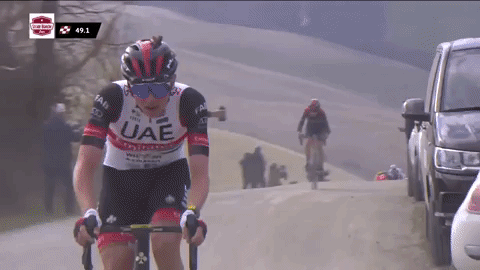
42.8km: Over the next five kilometers, Rodríguez is able to hang in no-man’s land, but Pogačar increases his gap to the peloton by 41-seconds by pulling it out to 1’06.
25km: And ten kilometers later, the gap between Pogačar and the peloton grows by 32 additional seconds out to 1’38, with Rodríguez now dangling just a few seconds in front of them. When we see Alaphilippe soft-pedaling back at this team car waving off help (or time gap info) from his director, we know the chase is over and Pogačar will stick this incredible win.
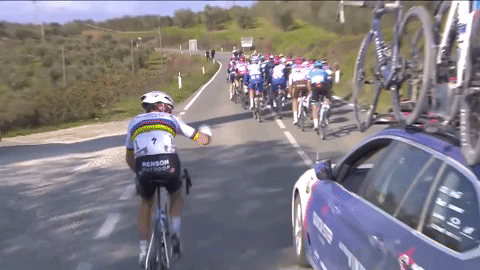
Finish: Pogačar is able to soak up the victory as he crosses the finish line the beautiful Piazza Del Campo, while Valverde, who has ridden away from the dysfunctional peloton with a select group, comes in for second 37-seconds down, with Kasper Asgreen rounding out the podium nine seconds later.
Final Top 3:
Tadej Pogačar +0
Alejandro Valverde +37
Kasper Asgreen +46
Takeaways 1-5:
1) Tadej Pogačar is the best bike racer in the world and a case could be made that he is even closing in on the best rider of all time, Eddy Merckx.
- Against some of the best riders in the sport, and the literal World Champion, he attacked from an ungodly long way from the finish line and won with relative ease. He had such control of both his bike and the race situation when he attacked that it almost looked like he was simply playing around. Considering his ability to win both grand tours and one-day races, Pogačar is undeniably the best bike racer in the world at the moment.
- And after finishing last season on pace to match the unmatchable Eddy Merckx, he has entered 2022 by winning both races he has lined up for (UAE Tour and Strade) and has kept on pace to become the new Cannibal.
- From 50km to 43km-to-go, he built up a gap of 1’06 over a chase group that was riding all-out to close him down. This is the moment the race was won and shows just how much stronger he was than anyone else in this race.
- But the most impressive part about Pogačar is his ability to weather slight positioning mistakes and his vast quiver of handling skills. Both of these were on display when he was able to nearly miss Wellens and Alaphilippe’s attack and then used the loose downhill with 50km-to-go to set up his race-winning move. Using this type of finesse move on the descent to set up his race-winning knockout on the ensuing climb shows such a supreme command on the racing situation and is what separates him from the other young stars like Remco Evenepoel, who may have the same level of physical talent.
2) For the second weekend in a row, we’ve seen a complete meltdown of a chase group and the advantage given to the rider who attacked and got away solo first.
- With 100% of the one-day WorldTour races so far in 2022 being won by solo riders, it is clear there has been an undeniable shift in the way chase groups work (or don’t work) together.
- My personal theory is that the rise of very basic strategic analysis in the sport has told riders that the one to step up to close a move down is dooming themselves to losing while setting up a rival for the win. But, as we’ve seen, if everyone follows this ethos, then the win will go to the first-mover every time.
3) Alejandro Valverde is incredible. At 41-years-old, he finished second place in a young man’s race (the average age of the winner over the past 8 years is 26yo) and significantly closed the gap to Pogačar in the process.
- It is tempting to ask if he could have won if he had counter-attacked earlier and started a real pursuit of Pogačar, but to do so would be to miss the point of Valverde’s brilliance: The main reason for his ability to rack up a stunning number of podium finishes at major races is that instead of going broke attempting to follow a single rider who is stronger than the rest, he simply follows wheels and picks up the others after they have exhausted themselves with the doomed chase.
- This style has likely cost him a major win or two throughout his career but has paid him back in far more consistent podium results.
4) After a few weeks of mid-pack results, Kasper Asgreen shows us that he is on form and should be ready to defend his Tour of Flanders title when the peloton returns north for the cobbled classics.
5) Ineos’ 21-year-old Carlos Rodríguez presented the only attempted response to Pogačar’s race-winning attack and held the gap impressively close until he was caught by the chase group. Combined with Jhonatan Narváez’s 7th place and the British former superteam had a good outing.
- The team has appeared to find a new generation of talent and both Narváez and Rodríguez will likely be contenders to grand tour stages later in the season.
- However, their pre-race leader, Richard Carapaz, was distanced when the race got difficult and is still not showing signs of any real form as the Ardennes and the Giro d’Italia approach.
Honorable Mention: Trek’s Quinn Simmons, at just 20-years-old, flashes his immense potential by getting 7th place in an extremely difficult race with only 87 finishers.
Paris Nice Stages 1 & 2
Race Notes
12.6km: Towards the end of the opening stage of Paris-Nice, Jumbo-Visma, who had been extremely attentive and active at the front of the nervous stage all-day, was setting a very hard pace.

6.5km: Perhaps the peloton assumed they were simply trying to keep Wout van Aert and Primož Roglič up-front and out of trouble and aren’t too concerned about the move, but if so, this is a mistake since as soon as his teammate pulls out, new recruit Christophe Laporte senses weakness lays down an infernal pace on a short climb.

6.3km: The acceleration catches the peloton off-guard, and everyone outside of Zdeněk Štybar is sent out the moon door as the Jumbo trio of Laporte, Wout van Aert and Roglič, plus Štybar, simply float away up the climb.
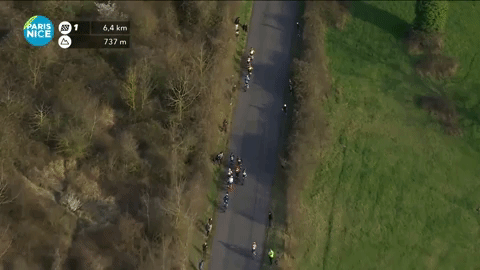
5.5km: Once they get to the top of the climb, the Jumbo trio has dropped Štybar and has such a large gap that they can’t even see the peloton behind. This means that the three strongest riders in the race are now off the front and settling into a perfectly-executed team time trial, while the rest of the peloton has to attempt to form a clunky chase group with misaligned incentives. Due to this, the race is already over at this point.
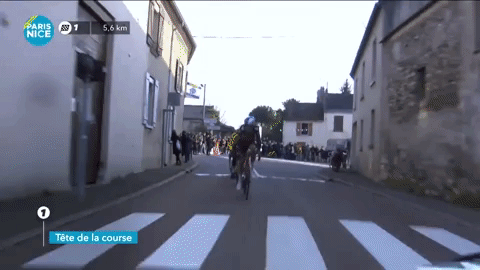
Finish: Van Aert and Roglič give Laporte the stage win and in turn, the race lead, while Roglič takes second and Van Aert third. The rest of the peloton comes in 22-seconds back, which is a devastating amount of time to lose on the opening stage of a week-long stage race.
Takeaways 6-8:
6) If there was any doubt before, there should be none now: Jumbo is officially the sport’s new superteam and their off-season strategy, which saw them add Laporte, is already paying dividends.
- They controlled the difficult cross-wind strewn stage all day and had enough power left to simply ride away from the peloton over a fairly benign hill. This shouldn’t happen at this level and they made a top-tier professional bike race look like three pros had joined a local group ride.
- It is possible that part of the reason they were able to build up such a large gap over a short climb is that the peloton simply didn’t believe they’d attempt it and thought they were too early in their lead out. Štybar is a strong rider, but frankly hasn’t been a top-tier racer for a few seasons, so the fact that he was the only rider able to make the split supports this theory.
- We could dissect their strategy for distributing the time bonuses at the finish line, but let’s be honest, it won’t matter by stage 8. Van Aert and Roglič are so much stronger than the rest of the GC contenders that the race won’t be coming down to just a few seconds.
Stage 2
In today’s second stage, after blowing up the race in the crosswinds in an attempt to distance GC and sprint rivals, Jumbo gets the jump on Fabio Jakobsen and his QuickStep team when race-leader Laporte goes over the top QuickStep with Van Aert on his wheel.
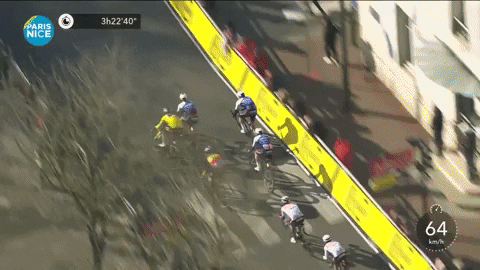
Finish: Despite this picture-perfect sneak attack, Jakobsen is able to grind his way onto Van Aert’s wheel in the split second before the train leaves the station and easily comes around him for the stage win.

Filtered GC:
Wout van Aert +0Primož Roglič +6
Pierre Latour +22
Ben O’Connor +39
Aleksandr Vlasov +39
Nairo Quintana +39
Adam Yates +39
Daniel Martinez +39
7) Jumbo blew up the stage in the crosswinds and appeared to have jumped QuickStep’s train in the finale, but the sprinting brilliance of Jakobsen was undeniable.
- The ability to weather Laporte and Van Aert coming by him and then re-setting for the sprint on their wheel shows both Jakobsen’s physical and tactical power in these high-powered sprints.
- Jakobsen has now won 13 of the last 17 bunch sprints he has taken part in and has an absurdly impressive 46% win rate in mass start races so far in 2022.
8) The best climber (Roglič) and best time trialist (Van Aert) in the race will get to head into their preferred terrain with a massive time cushion over the other GC contenders, who in turn need to be taking time on these stages to have a chance at the overall win.
- When we look at the time Van Aert and Roglič have pulled out on the other GC contenders before they have hit a single climb or time trial kilometer, the importance of their team strength is put into focus.
Tirreno-Adriatico Stage 1

Across the Alps, the rival Italian one-week stage race was getting underway. The big headliners of the stage were Filippo Ganna, Remco Evenepoel, and Tadej Pogačar (eventual 1st, 2nd, and 3rd on the stage).
Position Notes:
I consider Ganna to have one of the most graceful time trial positions in the peloton, but when placed side-by-side with Evenepoel, we see just how impressively aero Evenepoel’s position is. While Ganna has quite a bit of space between his hands and face, there is almost no space between Evenepoel’s hands and face. This decreases his CdA (coefficient of aerodynamic drag) significantly and allows him to keep up with Ganna, who is likely pushing around 100 watts greater for the duration of the event (however, if Ganna attempted to mimic Evenepoel’s style, he would likely suffer a decrease in power and leave him slower than his slightly less aero current position).

Stage Top Five:

Select GC Riders Time Loss:
Evenepoel +11
Pogačar +18
Miguel Ángel López +42
Tao Geoghegan Hart +42
Richard Carapaz +47
Jonas Vingegaard +53
Takeaways 9-10:
9) Evenepoel rode a great race and proved he is a great time trialist, but Ganna proved that when he is dialed in and focused, there is no one better against the clock.
- Evenepoel averaged an estimated 6.6 watts per kilo (roughly 400 watts) over the 15-minute effort, but Ganna went faster at an estimated 6.4 w/kg (542 watts). This might be surprising, especially considering Ganna appears to be less aero, but people tend to misunderstand watts per kilo. While it is an important factor, it isn’t a binary measure of speed, and raw power matters more as the grade of a road decreases. It is important to remember this since, outside the steepest climbs, the watts per kilo should be used as a guide, not a direct correlation to speed.
10) Even after his great time trial, Ganna will struggle to hold off Pogačar to win the overall when the race hits the mountains. And while Evenepoel leaves the first stage with a slight head start, I believe we are about to see the massive gulf that exists between the two riders’ ability on explosive final climbs.

- And if anyone thought Pogačar’s time loss in the time trial might be due to tired legs from his long-range attack on Saturday, when we look at the data provided from the final 2.5kms of the stage, we see that it was likely more of a pacing issue since Pogačar rode the final quarter of the course faster and with a higher average power output.
Evenepoel/Pogačar Power/Speed Data From Last 2.5km
Remco Evenepoel
57.4km/h
420w-Avg
545w-Max
Tadej Pogačar
57.6km/h
460w-Avg
760w-Max
